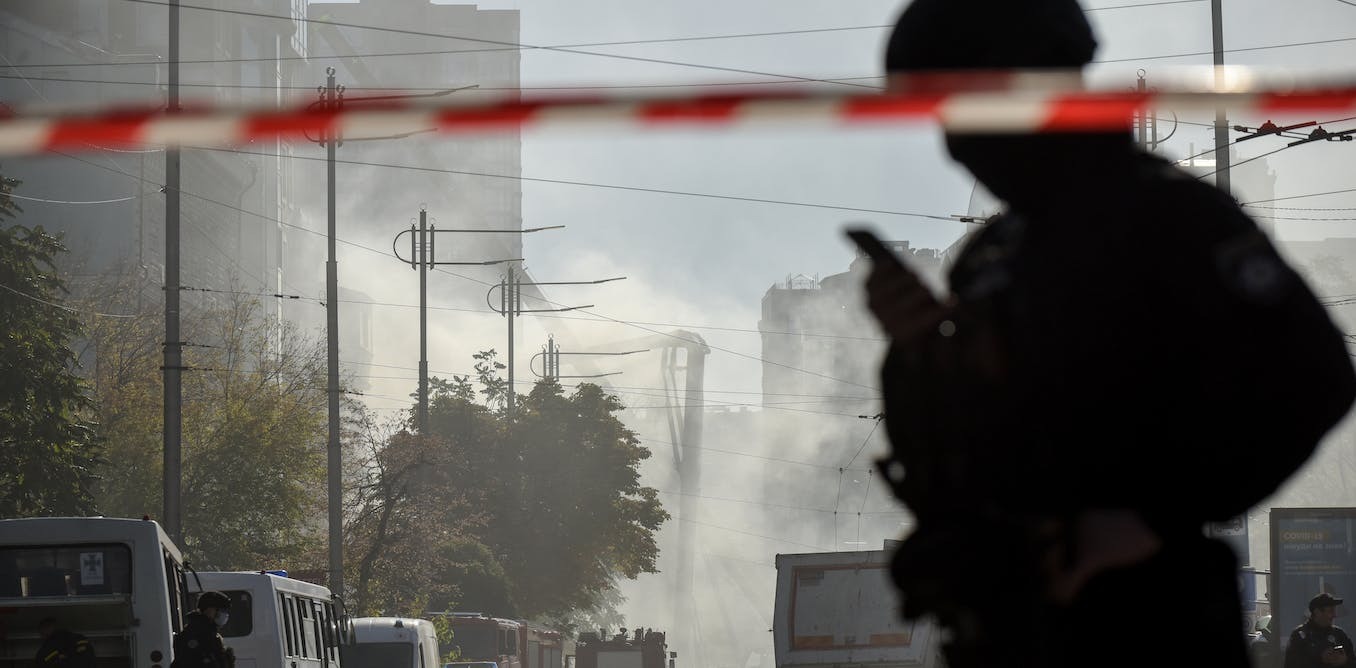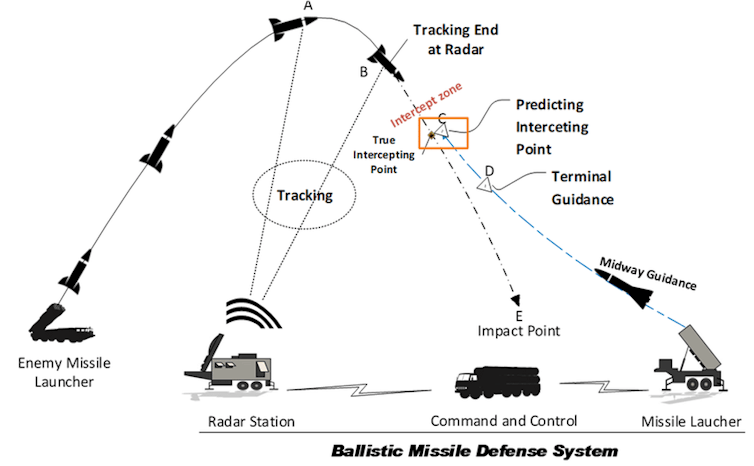Having suffered several weeks of setbacks in the field, Russia appears to have renewed its assaults on Ukraine’s major cities, mainly via missile and drone attacks. Despite protestations to the contrary from Kremlin ally Iran, there is growing evidence that Russia is using large numbers of Iranian drones. This includes the Shahed-136 “kamikaze” drone, which has a range of more than 2,000km. This allows Russia to strike at population centres well behind the lines of contact.
On October 17 alone, 43 of these drones attacked Kyiv, killing four people and destroying vital civil infrastructure. Drones expert Dominika Kunertova of the Center for Security Studies in Zurich runs through the various classes of drone and concludes that while they can exert considerable psychological pressure in terms of damage to the Ukrainian people’s morale, they are unlikely to directly influence the outcome of the war.
Russia’s recent approach has been to use drone and missile strikes to target Ukraine’s power and water infrastructure. Some 30% of Ukraine’s power stations were destroyed in eight days of strikes, as a result of which Ukrainians are bracing for a winter of power outages and considerable hardship. Benjamin Jensen of Marine Corps University in Virginia writes that attacks on infrastructure have long been part of Russia’s strategic playbook and have extended to massive and sustained cyber attacks targeting Ukraine’s information systems.
Jensen also believes that Putin has one eye on the west as he pursues this strategy. The attack on the Nord Stream gas pipelines, for which Russia is also prime suspect, is also meant to convey a strong message of what he is prepared to do if he thinks it necessary.
Ukraine’s president, Volodymyr Zelensky, meanwhile has renewed his pleas to western governments to supply air defence systems to protect his country against these attacks. The US is known to have highly sophisticated air defence systems, but they are very expensive and not 100% fail-safe in a situation of all-out war.
The fundamental elements of a missile defense system. Nguyen, Dang-An et al., CC BY-NC
But Iain Boyd, a professor of aerospace engineering sciences at the University of Colorado Boulder, believes that if Ukraine could obtain a sufficient quantity of these defensive systems, it would put a severe strain on Russia’s missile stockpile. And, as we have already seen, Moscow will not want to rely on Russia’s ground troops to do the job alone.
‘Rogue’ Russia
After the recent coup d'etat in the west African country of Burkina Faso, one thing many people remarked upon was how quickly after the coup Russian flags started to appear on the streets of the country’s capital, Ouagadougou. The boss of the private mercenary Wagner Group, Yevgeny Prigozhin – a Putin confidant – congratulated the coup leaders, saying: “The people of Burkina Faso were under the yoke of the colonialists, who robbed the people as well as played their vile games, trained, supported gangs of bandits and caused much grief to the local population.”
The Wagner Group has been active across Africa for some time supporting Russia’s fight to supplant the influence of the former colonial powers, France and the UK. Meanwhile it has propped up the Assad regime in Syria and is developing an ever-closer relationship with Iran. On the eastern fringes of Europe, Russia has fomented unrest in the breakaway republics of Transnistria in Moldova and Abkhazia and South Ossetia in Georgia.
David Dunn, professor of international politics at the University of Birmingham, believes that this – and the Kremlin’s nuclear sabre-rattling over his invasion of Ukraine – should be ample proof that Putin’s broader aim is to remake the system of international security in Russia’s favour. Dunn says the way this war ends will have enormous significance beyond Ukraine’s borders.
Monica Duffy Toft, meanwhile, believes Washington is only too aware of this – as demonstrated by the volume of military aid the US is supplying to Ukraine. Toft, a professor of international politics at Tuft University in Massachusetts, says that while the US is technically not at war with Russia, this is a classic proxy war. It’s the sort that the US and the Soviet Union/Russia have been fighting off and on since the end of the second world war.
There has also been a great deal of speculation that Belarus might enter the conflict in support of Russia. The movement of thousands of Russian troops to the border between Belarus and Ukraine, as well as the number of joint exercises and the apparent close client relationship Putin enjoys with Belarus president Alexander Lukashenko, have all served to make that idea more credible.
But as Jennifer Mathers of Aberystwyth University notes here, Lukashenko’s grip on power remains tenuous after his savage suppression of unrest following what many saw as a fixed election in August 2020. And Belarus is a conscript army in a country where polls regularly suggest that less than 10% of people support sending their own soldiers to fight. Sending hisn troops to fight and possibly die in Ukraine would be unpopular and would leave Lukashenko vulnerable, she writes.
Winning friends and influencing conflicts
Another region where Russia has been active is Latin America. It was notable that of the 33 Latin American and Caribbean countries present for the US-backed UN general assembly vote on Russia’s suspension from the human rights council earlier this year, 13 either abstained or voted against the resolution.
Nicaragua has gone further as one of four countries to vote with Moscow against the UN resolution condemning the recent annexations of four Ukrainian regions occupied by Russia forces (the others were Syria, North Korea and Belarus). José Caballero and Arturo Bris of the International Institute for Management Development (IMD) believes that, having neglected its own backyard, Washington has some serious work to do to get Latin America onside.



 Trump Signals Two Final Candidates for Fed Chair, Calls for Presidential Input on Interest Rates
Trump Signals Two Final Candidates for Fed Chair, Calls for Presidential Input on Interest Rates  Colombia’s Clan del Golfo Peace Talks Signal Mandatory Prison Sentences for Top Leaders
Colombia’s Clan del Golfo Peace Talks Signal Mandatory Prison Sentences for Top Leaders  Belarus Frees 123 Political Prisoners in U.S.-Brokered Deal Over Sanctions
Belarus Frees 123 Political Prisoners in U.S.-Brokered Deal Over Sanctions  Global Leaders Condemn Deadly Antisemitic Shooting at Sydney’s Bondi Beach During Hanukkah
Global Leaders Condemn Deadly Antisemitic Shooting at Sydney’s Bondi Beach During Hanukkah  California, 18 States Sue to Block Trump’s $100,000 H-1B Visa Fee
California, 18 States Sue to Block Trump’s $100,000 H-1B Visa Fee  Thailand Vows Continued Military Action Amid Cambodia Border Clash Despite Trump Ceasefire Claim
Thailand Vows Continued Military Action Amid Cambodia Border Clash Despite Trump Ceasefire Claim  International Stabilization Force for Gaza Nears Deployment as U.S.-Led Planning Advances
International Stabilization Force for Gaza Nears Deployment as U.S.-Led Planning Advances  Ukraine’s NATO Concession Unlikely to Shift Peace Talks, Experts Say
Ukraine’s NATO Concession Unlikely to Shift Peace Talks, Experts Say  Supporters Gather Ahead of Verdict in Jimmy Lai’s Landmark Hong Kong National Security Trial
Supporters Gather Ahead of Verdict in Jimmy Lai’s Landmark Hong Kong National Security Trial  Korea Zinc Plans $6.78 Billion U.S. Smelter Investment With Government Partnership
Korea Zinc Plans $6.78 Billion U.S. Smelter Investment With Government Partnership  Russian Drone Attack Hits Turkish Cargo Ship Carrying Sunflower Oil to Egypt, Ukraine Says
Russian Drone Attack Hits Turkish Cargo Ship Carrying Sunflower Oil to Egypt, Ukraine Says  Special Prosecutor Alleges Yoon Suk Yeol Sought North Korea Provocation to Justify Martial Law
Special Prosecutor Alleges Yoon Suk Yeol Sought North Korea Provocation to Justify Martial Law  U.S. Intelligence Briefly Curtailed Information Sharing With Israel Amid Gaza War Concerns
U.S. Intelligence Briefly Curtailed Information Sharing With Israel Amid Gaza War Concerns  New Epstein Photos Surface Showing Trump as Lawmakers Near Document Release Deadline
New Epstein Photos Surface Showing Trump as Lawmakers Near Document Release Deadline  Preservation Group Sues Trump Administration to Halt $300 Million White House Ballroom Project
Preservation Group Sues Trump Administration to Halt $300 Million White House Ballroom Project  Belarus Pledges to Halt Smuggling Balloons Into Lithuania
Belarus Pledges to Halt Smuggling Balloons Into Lithuania  Hong Kong Democratic Party Disbands After Member Vote Amid Security Crackdown
Hong Kong Democratic Party Disbands After Member Vote Amid Security Crackdown 

































